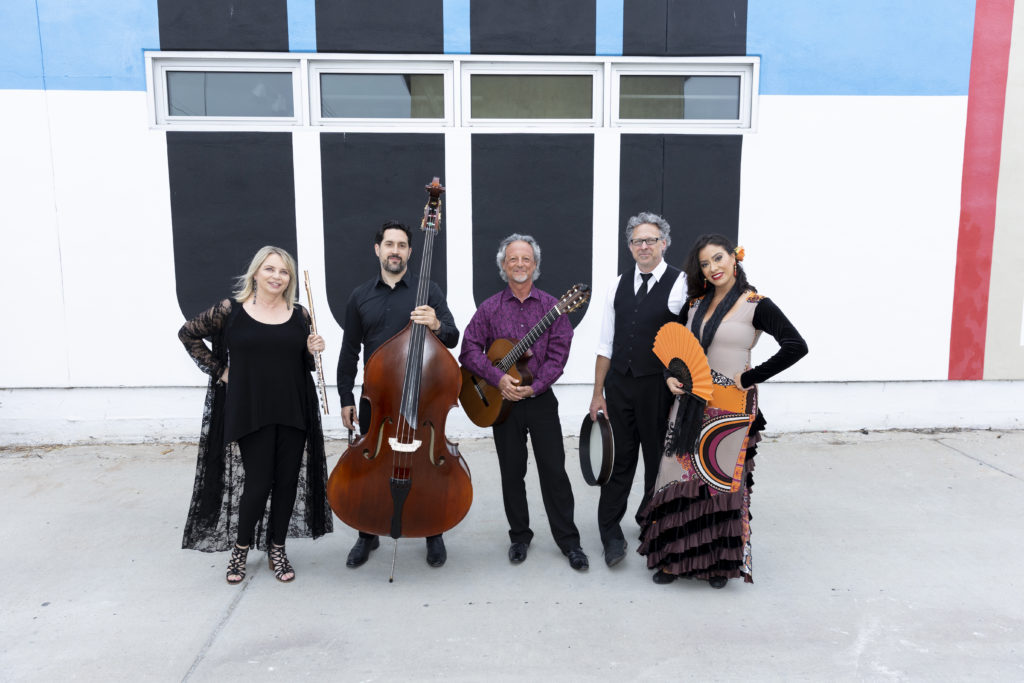Camarada Celebrates Flamenco Traditions of Music and Dance in the Barrio
It is safe to say that Camarada’s Flamenco Fantástico concert Saturday at Bread & Salt in Barrio Logan lived up to its billing. Four instrumentalists and a dancer proved more than sufficient to evoke the exotic and slightly erotic Andalusian spirit.
Although no two musicologists will define flamenco the exactly same way, most agree that Arabic, Jewish, Roma, and perhaps even Flemish and Indian musical traditions mingled in southern Spain to produce what is called flamenco.

Beth Ross Buckley, Andrés Martín, Fred Benedetti, Matt Armstrong & Gloria Lanuza [photo courtesy of Camarada]
Three Sephardic Songs in an instrumental arrangement by Benedetti and George Svoboda for flute, guitar, and percussion opened Camarada’s flamenco program. In the first song, “Partos Trocados,” flutist Beth Ross Buckley’s dark and languid alto flute themes shimmered over the gentle, persuasive accompaniment of Benedetti and Armstrong. “Aire de Mujer” turned into a spirited triple meter dance filled with complex guitar melodies and assertive contrabass strumming from Andrés Martín. Lanuza joined the final song, “El Rey Nimrod,” an even more frenzied dance propelled by exuberant bass and percussion.
In the late 19th Century, both through performance and composition Spain’s Francisco Tárrega elevated the classical guitar to a status we now take for granted in western musical tradition. The style of “Capricho Arabe,” one of Tárrega’s most celebrated guitar solos, pays tribute to the Moorish influence on Spain’s music, and Benedetti’s masterful account gave the work its due. Long a staple of his solo repertory, his nuanced phrasing of “Capricho Arabe” suggested an inspired improvisation, which it most likely was before the composer notated it.
Andrés Martín, who appears to be Camarada’s unofficial composer in residence, contributed his Suite para Contrabajo y Guitarra Flamenca, a three-movement opus in which the Argentine composer salutes flamenco style. Since the contrabass is Martín’s instrument, we were not surprised that after the first movement’s modest solo guitar introduction, the contrabass enters with sweeping themes in the instrument’s highest register that quickly evolve into a wide-ranging melismatic lament. In “Canción,” the second movement, the guitar provides a reflective moment in the contrasting major mode and adds a delicate descant to the luxurious cantilena played by the contrabass in its glowing, lowest range.
Martín adds flute and an unrelenting percussion pulse to the exultant final movement, “Milongitana.” Just two weeks ago, the San Diego Symphony performed Martín’s Double Bass Concerto No. 1, so Señor Martín and the contrabass should be enjoying this time in the limelight.
Even piano students of moderate achievement are probably familiar with Ernesto Lecuona’s “Malagueña,” a flamboyant piano solo the Cuban composer wrote as a movement in his 1927 Suite Andalucia. Cuba proudly claims Lecuona, but his father was Spanish, and “Malagueña” may be described as a spirited fandango from the city of Málaga on Spain’s southern coast. Camarada’s arrangement included all four of this concert’s instrumentalists, with Gloria Lanuza adding vivacious dance to the work that crowned Camarada’s flamenco extravaganza.
Camarada presented this concert on Saturday, May 7, 2022, at Bread & Salt located at 1955 Julian Ave., San Diego, CA.

Ken Herman, a classically trained pianist and organist, has covered music for the San Diego Union, the Los Angeles Times’ San Diego Edition, and for sandiego.com. He has won numerous awards, including first place for Live Performance and Opera Reviews in the 2017, the 2018, and the 2019 Excellence in Journalism Awards competition held by the San Diego Press Club. A Chicago native, he came to San Diego to pursue a graduate degree and stayed.Read more…
